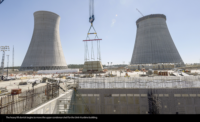A recent announcement by electric utility Arizona Public Service could mark the tipping point in the way utilities think about building resources to meet peak demand.
Historically utilities built “peakers,” usually gas turbines fueled by natural gas, to meet spikes in demand, but in recent solicitations Arizona Public Service chose battery storage projects over peakers. “This is a watershed moment that the utility is signaling,” says Manish Kumar, managing director for energy storage at AES Corp.
Late last month, APS, the largest utility in the state, said it plans to add 850 MW of energy storage by 2025, including 200 MW of stand-alone energy storage projects that competed and won against gas-fired peakers.
Gas-fired generation did make a showing in the solicitation, but it was for the output of an existing plant, not a more expensive, new-build plant. Retail power provider Calpine won a power purchase contract to deliver power to APS from one of its gas plants, but only during the summer and only for seven years. After the contract expires, APS is looking at building another 500 MW of energy storage plants, but the timing of additional solicitations has not been finalized.
APS wants the battery storage to extend solar power generation into its peak load hours. The first 200 MW of projects will be installed at eight existing solar plants.
AES was one of the winners of APS’ April solicitation for peaking resources. The Arlington, Va., based company won a contract to build and own a 100-MW storage project in Sun City. Invenergy LLC, Chicago, won a contract for a 50-MW storage plant in El Mirage.
For years, proponents of energy storage have argued batteries are better suited to meet peak demand because, unlike gas peakers that might run only a couple of hours a year, a battery can provide voltage support or other services when it is not providing peaking power. Until recently, however, utilities have been reluctant to take that leap.
“It is a groundbreaking moment in part because this a utility in a state which is traditionally gas friendly,” says Ray Hohenstein, market applications director at Fluence, a joint venture of AES and Siemens that provides energy storage equipment and services. “It is a continued recognition of where storage is today,” he says, “and where [APS] sees storage being in a handful of years.”
Chris Ruckman, energy storage director, Burns & McDonnell, says: “APS has jumped to the forefront of storage deployments in the U.S. and is demonstrating that solar combined with battery storage is a viable and powerful option for meeting peak demands with clean energy. Based on inquiries we are receiving from utilities and developers, I believe the majority will be striving to catch up to APS in 2019. … Nearly every utility is now evaluating solar and storage as a true peaking resource. As recently as 2017, there were only a handful of utilities who were thinking about this option. This trend is pushing the whole U.S. power industry toward a new frontier in energy storage and decarbonization.”
Energy storage is “the technology of the future,” Kumar says, saving money for both the utility and for ratepayers. “I think we are going to see this happen in other utilities in Arizona.”
The linchpin in the peaker-storage debate is the rapidly declining costs of lithium-ion batteries. The APS solicitation shows “the predicted crossover point has now been reached,” says Jesse Jenkins, a postdoctoral Environmental Fellow at Harvard University, who wrote a 2016 paper predicting batteries were on their way to winning out against gas peakers.
Last summer, Pacific Gas and Electric said it would seek regulatory approval to build three storage projects totaling 567.5 MW in California.
Replacing a peaker is one thing, though. Replacing a gas-fired combined-cycle plant that runs most of the year is an entirely different challenge, Jenkins says. “I’d expect a brisk market for battery sales as peaker alternatives in the coming years,” he says, “but don’t expect storage to replace the vast majority of megawatt hours from gas-fired power plants.”





Post a comment to this article
Report Abusive Comment